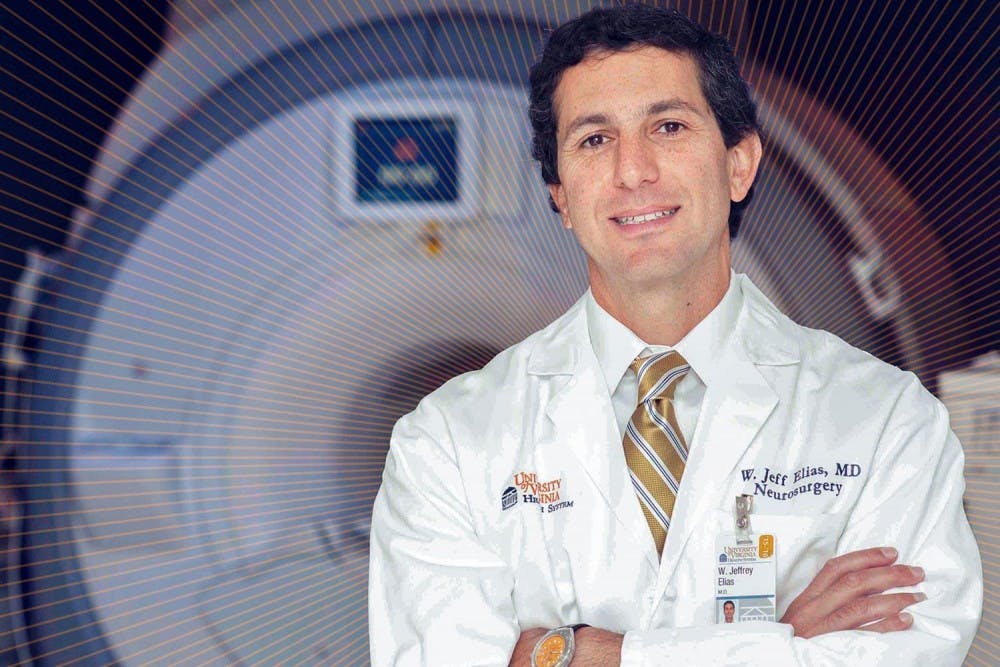Dr. Jeffrey Elias, the 2018 Edlich-Henderson Innovator of the Year, drives a trend in treating essential tremors with a new non-invasive technique called focused ultrasound.
Essential tremor is a neurological, movement disorder that causes an uncontrolled shaking of various parts of the body. This disease complicates even the most simple, routine tasks for individuals, like holding a cup of water or buttoning a shirt.
“In essential tremor, if we look at the brain under a microscope, there is no difference between the people who have essential tremor versus people who don’t,” Asst. Neurology Prof. Dr. Binit Shah said. “But the signals that run through some of these pathways can be abnormal, or there can be overexcitability.”
Although the cause for ET is currently unknown, this disease often runs in families, indicating that it could be due to a genetic mutation. There are an estimated 10 million cases of essential tremor in the United States. The Focused Ultrasound Foundation hopes that more people will receive focused ultrasound therapy to treat this disorder.
“Focused ultrasound is an early-stage, non-invasive therapeutic technology that could serve as a game-changing disruptive alternative to surgery, radiation therapy and drug delivery,” said Dr. Neal F. Kassell, founder and chairman of the Focused Ultrasound Foundation.
Through the focused ultrasound technique, a precise area of brain tissue that has defective nerve cells causing the tremors is destroyed using sound waves. These sound waves heat and destroy the target cells without affecting other areas of the brain.
“What focused ultrasound does is it targets one area where there is kind of a lot of these tremor signals or overactivity that go through one structure, in this case part of the thalamus of the brain and it zaps that area or lesions that area to prevent the abnormal signals from propagating further,” Shah said.
This technique has the potential to provide a multitude of benefits because it avoids the use of anesthesia, incisions in the scalp, and burr holes in the skull. This allows patients to recover faster and avoid the harmful side effects of surgery and anesthetics.
An international study conducted by Elias using the focused ultrasound device found that this treatment resulted in improvements in hand-tremor scores and secondary outcome measures assessing the quality of life for ET patients. The success seen by this study prompted the FDA to approve this procedure in July 2016.
Although the use of focused ultrasound has proved to be beneficial to patients, the procedure carries risk factors. However, compared to the earlier stages in the development of this drug, the complication rates and side effects of the treatment have decreased as the people have gained more experience and the technology has become more mature.
“Just like if operating on a patient, if you put your knife in the wrong spot, you can cause damage,” Kassell said. “The complication rate is equal to or lower than any of the surgical invasive or minimally invasive alternatives.”
It is also important to note that focused ultrasound has currently only been found safe to treat one side of the body. Therefore, this technique may not be safe to recommend to patients suffering from symptoms on both sides of their body.
The studies conducted at the University have been funded in large part by the Focused Ultrasound Foundation.
“U.Va. was the perfect place for this focused ultrasound treatment of essential tremor and Parkinson’s disease to get going,” Kassell said. “We have strong neurosurgery, neurology, biomedical engineering and radiology departments interested in movement disorders.”
The focused ultrasound treatment not only provides therapeutic benefits for ET, but shows potential for a wide range of other neurological disorders like Parkinson’s disease, dystonia, ALS, epilepsy, OCD, depression and benign and malignant tumors of the brain.
This treatment can also target a variety of other medical conditions such as musculoskeletal diseases like osteoarthritis and cardiovascular diseases like atherosclerosis. Kassell believes that overall, this treatment holds great potential in the world of medicine.
“[Focused ultrasound] is the most powerful sound that you will never hear, but you should listen carefully because it is sound that could someday change your life,” Kassell said.







